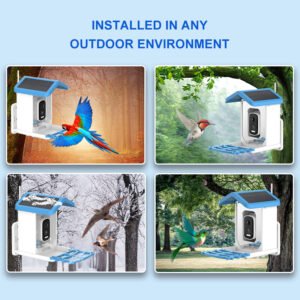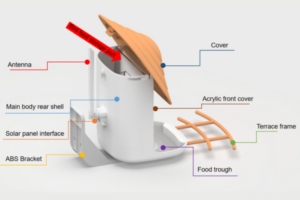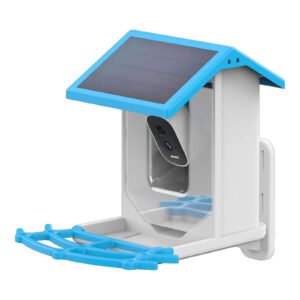Are you struggling with attracting birds to your suet feeder? This common issue can lead to disappointing results, leaving your feeder unused. The right placement of your suet bird feeder is essential for drawing in birds and providing them with the nutrition they need. In this article, we will walk you through the best practices for hanging a suet bird feeder to maximize its effectiveness and ensure a successful bird-watching experience.
Choosing the right location to hang your suet bird feeder is crucial for attracting the right birds. Whether you’re looking to add beauty to your garden or support local wildlife, proper placement will make a big difference.
Want to learn how to optimize your suet bird feeder placement? Keep reading for tips on how to attract more birds with simple adjustments.
Where Should I Hang a Suet Feeder?
When deciding where to hang a suet bird feeder, it’s important to choose a spot that is visible to birds while also providing safety and comfort. Look for an area near trees or shrubs, as birds often like to feel sheltered. A tree branch is a perfect spot for hanging your suet feeder, as it allows birds to approach the feeder safely and offers protection from predators.
Additionally, placing the suet feeder in a quiet corner of your yard, away from heavy foot traffic, will provide birds with a peaceful environment where they feel comfortable feeding. Avoid areas near fences, walls, or any location that could attract squirrels or other animals that might try to steal the suet.
How High Off the Ground Should a Suet Feeder Be?
The height at which you hang your suet feeder plays a critical role in attracting birds while keeping it safe from predators. Experts recommend placing the feeder at least 5-6 feet above the ground to keep it out of reach of squirrels and other ground-dwelling animals. This height also gives birds the space they need to approach the feeder without feeling threatened.
If you have a squirrel-proof suet feeder, you can place it at a lower height. However, it’s still a good idea to avoid placing it too low to prevent larger animals from accessing the food. Higher placement ensures better visibility for birds and greater protection.
What Is the 5 7 9 Rule for Bird Feeders?
The “5-7-9 Rule” is a popular guideline for positioning bird feeders, including suet feeders, to maximize bird visitation. The rule suggests that you should aim for the following:
- 5 feet: Place your feeder 5 feet from any vertical structures such as tree trunks or fences to prevent squirrels from leaping onto the feeder.
- 7 feet: Hang your feeder at least 7 feet away from any horizontal surfaces, including decks or ledges, that could allow squirrels to jump onto the feeder.
- 9 feet: Keep the feeder at least 9 feet from the ground to avoid attracting predators like cats, dogs, or other animals that could harm the birds.
This simple guideline helps reduce the risk of unwanted guests while providing a safe feeding environment for birds.
How Long Does It Take for Birds to Find a Suet Feeder?
It can take anywhere from a few days to several weeks for birds to find a newly hung suet feeder. Birds are often curious about new food sources, but it can take time for them to notice the feeder, especially if it’s located in a quieter area. One way to speed up this process is by using bird calls or placing the suet feeder near known bird habitats to attract their attention.
Don’t worry if birds don’t immediately flock to the feeder. With patience and consistent feeding, you’ll soon see regular visitors enjoying your suet feeder.
How Do I Get Birds to Come to My Suet Feeder?
To attract birds to your suet feeder, you need to offer them a safe and welcoming environment. One effective way is to place the suet feeder in an area that is accessible yet sheltered from the wind. Additionally, adding a variety of suet blends can attract different types of birds. Try using suet with nuts, seeds, or fruits, as these can appeal to a range of bird species.
Furthermore, keeping the suet fresh and replenishing it regularly ensures that the birds keep coming back. You can also consider placing a few birdhouses nearby to offer additional shelter and nesting spots for birds.
Should You Give Birds Suet in the Summer?
Many people believe that suet should only be offered in the colder months, but this is not entirely true. Birds can benefit from suet in the summer, especially during the breeding season when they need extra energy to care for their young. However, you should be cautious in hot weather, as suet can melt and spoil quickly.
To prevent this, consider using a summer-specific suet blend designed to withstand higher temperatures. Alternatively, you can use suet feeders that feature mesh cages to allow airflow, keeping the suet cool and fresh.
What Eats Bird Suet at Night?
While birds are the primary consumers of suet, other animals may be attracted to your feeder, especially at night. Common nocturnal suet feeders include raccoons, opossums, and even squirrels. To prevent these animals from stealing your suet, you can install a suet feeder with a squirrel-proof design or place the feeder in a location that is hard for nocturnal creatures to access.
For added protection, consider using a suet feeder with a tight-fitting cage or a feeder that only allows smaller birds to feed.
How Far Away from the House Should a Bird Feeder Be?
When positioning your suet feeder, consider how far away it should be from your home. Ideally, place it at least 10 feet from windows or doors to prevent birds from flying into glass surfaces. This distance also provides birds with more privacy and less disturbance from human activity.
A well-placed suet feeder at a reasonable distance from your house will make for a more enjoyable bird-watching experience and offer birds a peaceful environment to feed.
Does Suet Attract Rats?
Rats and other rodents are attracted to food sources, including suet. If your suet feeder is left unchecked or easily accessible, it may become a target for rats. To minimize this risk, make sure the suet is placed in a squirrel-proof or rat-proof feeder. Additionally, keep the area around the feeder clean and avoid dropping crumbs that may attract rodents.
You can also opt for suet blends that contain ingredients that rats tend to dislike, such as spicy peppers, to deter them.
Summary
Proper placement of your suet bird feeder is key to attracting a wide variety of birds and ensuring they return regularly. By following these tips and considering the needs of both birds and your surroundings, you can create a successful feeding station that benefits both wildlife and your backyard.






